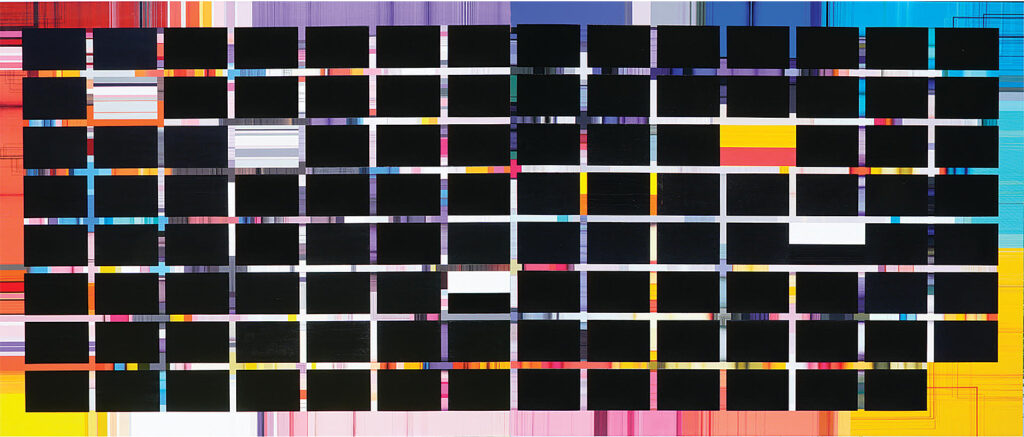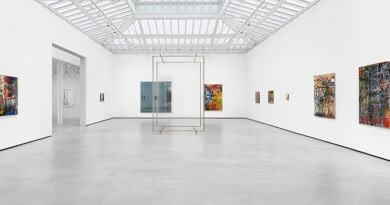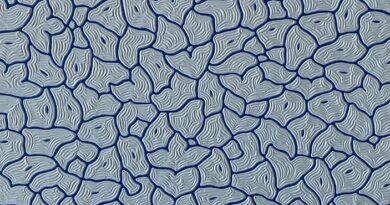spatial sensation in paintings by hayri esmer
MÜMTAZ SAĞLAM
Hayri Esmer appears to present the problematic he tries to define with the concepts of “Space and Border” through the metaphors and structural elements placed onto aesthetic level and visualize them through an envision that seems abstract and decomposed. This quest emphasising a necessity for an ideal level actualises itself not through external worldly and nature-oriented references but through symbolic meanings associated with direct systematic and intellectual methods. Within the frame of such subjective affectivity, there exists a whole perception established with the contradictory and concordant relationships of structural elements whose spatial connections are highly powerful as well as a quality interpretation that becomes privileged with awareness and sustainability occurs to us.

Hayri Esmer’s art journey is in development encompassing radical transformations with devotion to coherent and realistic experiments. Its strength lies in quests and discussions conceived at relatively more fictional and ideational level as well as in the reckonings swiftly ensuring a form-meaning balance. Particularly in a perspective that looks critically into life which is unprincipled, unsteady and complex, Hayri Esmer’s art is directed towards the argument of balance-order and struggle to develop potentials of abstract and geometric figuration language.
There is no doubt that (t)his understanding of painting has the potential to transform the social and political views it implies into historical and political criticism. However, it will be more accurate to try to explain (t)his distance-based approach having no specific reference with his own reasoning and to liberate it as the phenomenon of spatial experience. Moreover, it is also necessary not to narrow down the scope of abstract discipline embarrassed by this approach by associating it with the scope of language and discourse of this order which is multiplying with the name “nameless” but to evaluate it through the associations created with reference to an experiential culture. For instance, images with often used labyrinth associations metaphorically transform this envision into a painting-design issue evolving into a urban texture. Or it extends it towards a dimension internalizing the word wall and its concept with an architectural attribution. We might remember that the painter who have previously opened a similar thematic space with the concept of window has problematized the spatial private and psychic dimensions such as inside-outside or home-room, with an awareness into the high possibility of using architectural references
Hayiı Esmer, in this world he has constructed, puts the symbolic attributes of painting into complexity by using block or panels implying the wall surfaces constructed by him rather than intertwining it with noticeable codes. In this way, in the colourful and abstract order, he intends us to comprehend the surface as a contradictory coherence by creating variations with decorative attraction through chimeric influences. What we have meant hitherto by the premise of logic of spatial experience emerges at this very point and enables us to describe the painting as a distinctive and meaningful way of seeing through an emotional and intellectual overload. This is because the blocks and colour spaces Hayri Esmer positioned at the vertical axis not only encompass a quality unique to a plastic texture in its own specific space, but also turn into major components that identify the language and tone quality of painting. Thanks to this, the painter keeping the surface of the painting alive by tension-creating motions carries the painting to an interesting point that establishes balance between plastic wholeness and content density. Here the formant freedom functioning with concerns about constructing interactive and permeant plans or space, and the relationships organizing the structural elements is in quest of creating an aesthetic-plastic case. Turning into a sheer experience, this act or practice of use, which gets conceptualized by transforming itself into settlements dispersed across horizontal, vertical and diagonal axis, aspires using the colour spaces appropriately and efficiently. This, in fact, is a challenging but very important process in that it identifies and uses the image corresponding to a self-initiating necessity or an idea. Moreover, the freedom that enables the array of the whole surface of a painting needs to actualise this in line with a part-whole dialectics
The preference for placing forms with geometric extensions into comic space coming into being as an abstract plane is, so to say, a sign of determination to come into contact with a genuine thought and to struggle with a representation at this level. On the other hand, the quest of absolute balance which becomes more and more visible at his point, in fact, reveals a need for a kind of freedom. Esmer, who thinks in this scope, seems to be looking for contemporary responses to the issues he derived from the interaction between colour, form, and surface. The painter, therefore, prioritizes a balanced envision of a dynamic space in line with the principles of perspective by keeping aloof from a narrative approach. In this space constructed on the basis of a non-symmetric understanding, a quest for transcendence seeking an impact and an increasingly excelling state come into question where a visual emerges appealing to interaction of mechanisms with vague shapes or even being shaped by concerns about designs. So, painting, in its own plastic world, seems to problematize a state of a new design, order, and balance emerging from the self with an internal dynamism struggling to excel the self.
In conclusion, Hayri Esmer appears to present the problematic he tries to define with the concepts of “Space and Border” through the metaphors and structural elements placed onto aesthetic level and visualize them through an envision that seems abstract and decomposed. This quest emphasising a necessity for an ideal level actualises itself not through external worldly and nature-oriented references but through symbolic meanings associated with direct systematic and intellectual methods. Within the frame of such subjective affectivity, there exists a whole perception established with the contradictory and concordant relationships of structural elements whose spatial connections are highly powerful as well as a quality interpretation that becomes privileged with awareness and sustainability occurs to us.
This sensitive approach focused on seeking an aesthetic impact and shaped in quest for a highly developmental ideal continues to transform itself in its unique world.
(Translated by Kenan Dikilitaş, 2017)
Mümtaz Sağlam, Copyright © 2022, Tüm hakları saklıdır. / All Rights Reserved.
Bkz. Boşluk ve Sınır / Space and Border / Hayri Esmer, (Katalog-Kitap), Kazım Türker Sanat Galerisi Yayını, Ocak 2018, İzmir.



